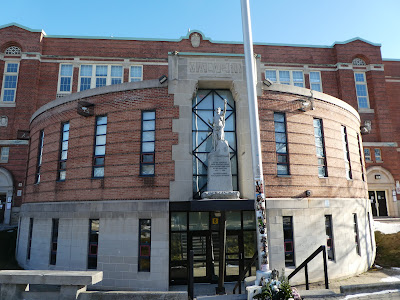Location City of Toronto N 43.68275 N -79.29358
On the front of the school, 55 Malvern Avenue.
This memorial is dedicated to the "Lost Boys of Malvern", those who left this east Toronto neighbourhood to fight in the Great War and never returned.
The following article is from CBC News in 2010:
"Outside Malvern Collegiate Institute, a high school in a quiet and leafy neighbourhood in Toronto's east end, stands a beautiful but battered statue of a young man in his prime — a tribute to the more than 60,000 Canadians who died fighting in Europe in the First World War.
The figure wears a toga, with one arm outstretched holding a chain that is meant to signify the shackles of militarism. The other arm, which once held a sword, is broken off at the elbow, with a rusted metal rod sticking out. Faded and barely legible are 25 names engraved on the base of the statue, the names of the boys of Malvern Collegiate who died in the war.
Students walk past the statue every day. Many are able to explain what it represents, but over the years the cenotaph, which has been around for almost 90 years, has become just another part of the landscape rather than a revered place.
The Malvern cenotaph is one of hundreds of war memorials across the country, built by small communities after the Great War to honour their "lost boys." With no bodies to bury at home (they were buried in the killing fields of France and Belgium), the cenotaphs served as substitute gravesites. Cenotaphs took various forms: some were monuments, some plaques, and many others were figurines of soldiers.
But the Malvern statue is one of the more beautiful, say its admirers, those in the community who have been lobbying over the years to get financing from the federal government, the school board, and anybody else, to fix it. The statue was created by a famous Canadian sculptor, Emanuel Hahn, the preeminent designer of war memorials of the 1920s. (He also later designed coins, and came up with the caribou design on our quarter and the Bluenose schooner on our dime.)
When the sculpture was unveiled with great fanfare at a ceremony in 1922, it unified a community in mourning. On one side of the base was engraved: "These at the call of King and Country lost all that was dear to them, endured hardness, faced danger and finally passed out of the sight of men by the path of duty."
East Toronto, as it was called then, had a population of about 5,000 (most of Scottish and English stock). Of that number, 1,000 men went to war, says Carole Stimmell, editor of the community newspaper the Beach Metro News, who has written about the statue and researched the Malvern boys it commemorates.
Weather and the passage of time have taken their toll on the sculpture. More recently there has also been petty vandalism and damage caused by the fact that the statue made for excellent climbing"....
Unfortunately, in recent years the monument is more well known for the constant need of repair due to weathering, but mostly due to vandalism, a sad statement on the education given beyond the walls of this school. Hopefully this memorial can be restored to its former glory in time for its 100th anniversary in May 2022.
Marker text:
Front:
TO THE MEMORY OF
THOSE FROM THIS SCHOOL
WHO LAID DOWN THEIR LIVES
IN THE GREAT WAR
1914 - 1918
MALVERN AVENUE
COLLEGIATE INSTITUTE
Left side:
CECIL PUGHANNS
WILLIAM KENEDY COMMINS MC DSO
GORDON PARSONS DAVIDSON
JOHN PATRICK DAVIDSON
GORDON EZRA DUKE
MARTIN JAMES FLOOD
CECIL JOHN FRENCH MC
ARTHUR PATRICK GORMAN
WILLIAM ALBERT HEAL
WILLIAM JOHN HIRD
WALTER THOMAS HUTCHINSON
WILFRED JOHN JONES
ROY WESLEY KERR
Right side:
CHARLES SIMPSON LENNOX
CHARLES WILLIAM MABBOTT
HARRY GEORGE MANSFIELD
CHARLES PERCY MAY
ROBERT FOUNTAIN MACLUCKIE
DONOVAN LAURIER SISLEY
ARTHUR JACKSON SMITH SISLEY
HAROLD WILLIAM SPENCE MM
JOSEPH ROLLIT TAYLOR
JOHN ARCHIBALD TREBILCOCK MC
ALSEY JOSEPH TREBILCOCK
MURRAY WATSON





















No comments:
Post a Comment
Note: only a member of this blog may post a comment.